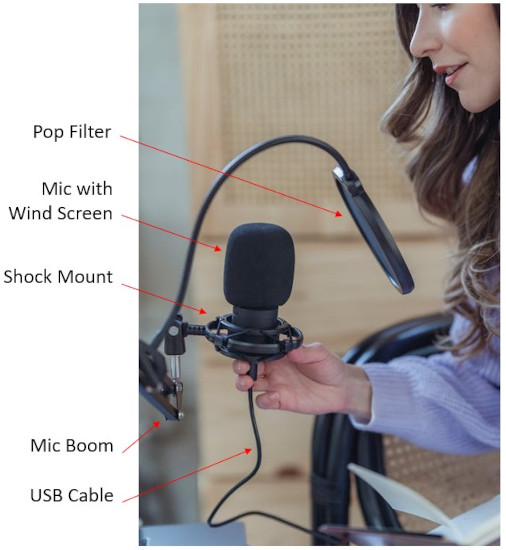What is a USB Podcast Microphone?
A USB Podcast Mic is a microphone that connects to a computer or personal device and captures the speech (not typically music) audio of one or two people to be used during a podcast, webcast, webinar, or other types of virtual session.
Why Use a Podcast Mic?
Because in the virtual world, you are how you sound.
Laptop and webcam mics capture speech audio, but usually offer marginal performance. And while a good quality headset can provide a great audio experience, some people don’t want to don a headset while on camera.
Podcast mics give you the audio performance – and cool look and feel – of a broadcaster.
How Much Do I Need to Spend?
That’s up to you. Basic podcast mics that perform well in quiet environments are available for $40 or less, while advanced podcast mics with additional features and capabilities may cost $100 or more.
TIP – whether you’re on a budget or not, make sure to check our USB Podcast Microphone Performance Ratings before you spend your money!
Should You Buy a USB or XLR Podcast Mic?
With podcast microphones, USB and XLR refer to the connector and type of cable used to connect to the microphone.
XLR connectors are the standard in the professional audio world because they’re easy to make in the field, rugged, reliable, and offer strong performance. But most computers don’t include XLR ports. So, if you purchase an XLR mic, you’ll need an XLR to USB interface or audio recorder to use that mic for podcasting or PC-based video content.
USB mics, on the other hand, are designed for use with PCs and laptops, so no additional adapters or interfaces are needed for podcasting and video content creation.
TIP – some microphones offer both USB and XLR connectors, but you’ll likely have to pay a bit more for this flexibility.
Other Connections and Ports
In addition to USB and/or XLR connections, some podcast microphones include 3.5 mm headphone jacks (to monitor your audio), additional audio inputs, or external power connections.
Which Should I Buy – A Condenser or Dynamic Mic?
Both condenser and dynamic mics are fine for typical podcasting or PC video applications, but there are pros and cons to each type.
Condenser mics typically offer better audio performance (meaning cleaner voice capture), while dynamic mics can capture loud volume with limited distortion.
So, if you’re creating content in a relatively quiet place (e.g., an office or studio), go condenser. If you’re creating content in a loud environment (e.g., concert venues, trade show floors, etc.), a dynamic mic might make more sense.
Which Pickup Patterns Do I Need?
Microphone pickup patterns (a.k.a. polar patterns) describe the space around the mic where the mic picks up sound the best.
 |
This image, provided courtesy of Blue / Logitech, shows four common pickup patterns found on podcast microphones.
In general, to minimize unwanted background noise, you should use the smallest or narrowest pattern that suits your needs. For example, if you’re the only talker on a podcast, a cardioid pickup pattern would be ideal. But if you’re interviewing someone sitting across from you, a bi-directional (a.k.a. figure 8) pattern would make more sense. However, if you’re looking to capture the “feel” of the space and not just your voice, an omni-directional patter might make more sense. Note, however, that this may cause the mic to pick up more background noise. Some mics offer only one pickup pattern, while others offer two or more. Check out the Product Comparisons page to see which mics offer which pickup patterns – and at what price. |
Specs and More Specs
There are many specifications (or specs) vendors use to describe the technical performance of their microphones. While each spec is important in its own way, most podcast users should at least consider the following three specs:
Frequency Response – describes the range of frequencies that a microphone can capture. For example, a frequency response of 20 Hz – 20 kHz means the mic can capture (meaning hear) sounds as low as 20 Hz (extremely low bass) and 20,000 Hz (a higher tone than most people can hear).
As a point of reference, male voices typically range from 100 Hz to 8 kHz, while female voices range between 350 Hz and 17 kHz (source: https://seaindia.in/blogs/human-voice-frequency-range/)
Sample Rate – describes how often digital samples of the analog audio signal are taken. In general, a higher sample rate will provide better audio quality.
To capture a signal without significant flaws, the sample rate must be twice the highest frequency. For example, to capture a 20 kHz audio signal, a sample rate of at least 40 kHz is needed.
Most USB podcast mics use a 48 or 96 kHz sample rate, which is more than sufficient for standard podcasting or content creation. However, for professional content creation with audio editing and post-processing, a higher sample rate (e.g., 192 kHz) is preferred.
Bit Depth – refers to the number of bits of information contained within each digital sample of the analog audio signal. A higher bit depth allows the mic to capture a wider dynamic range, which is the ratio of the softest sound to the loudest sound.
A 16-bit bit depth supports a dynamic range of 96 dB (as loud as some rock concerts), while a 24-bit bit depth supports 144 dB (loud enough to cause ear damage and possible eardrum rupture).
For typical podcasting and content creation use cases, a 16-bit bit depth is more than sufficient.
Mounting Options and Accessories
There are many ways to mount a podcast mic.
 |
Some podcast mics include a mic stand and/or a tripod, while others include a mic boom with a table clamp.
Also, many podcast mics include a universal mounting thread or mounting adapter to allow the mic to be used with third-party stands, tripods, and booms.
In addition, some mics include accessories like shock mounts (to allow the mic to float freely and eliminate vibration noise), pop filters (a physical screen that reduces or eliminates popping sounds), and windscreens (to reduce or eliminate wind, air-conditioning, or breathing sounds).
Tip – When it comes to accessories, more is not necessarily better. However, to future-proof your purchase, look for mics with a universal mounting thread. |
Mic Controls and User Interface
Podcast mics range from extremely simple to amazingly advanced.
A simple mic might have no controls at all. With these mics, users simply connect the USB cable and start talking. More advanced mics offer a wide range of controls and status indicators.
For example, some mics include just a physical mute button and LED indicator, while others might add a pickup pattern selector knob, mic gain and headset volume controls, customizable LED lights, and more. Some mics even include an LCD display or touchscreen.
Tip – Don’t buy more features than you need. Instead, focus on audio performance and ease of use. A well-performing mic with the features you need is better than a poorly-performing mic with tons of features and controls.
Included Software Applications
Some USB podcast mic vendors offer free software with their microphones.
In some cases, the free software offers only a few functions (e.g., firmware updates or basic mic control). In other cases, the software provides access to a wealth of features and controls ranging from additional mic settings to professional DSP functions (e.g., filters, compressors, AGC, and more).
Tip – while every podcast mic can be used straight out of the box, the bundled (and usually free) software apps can take your audio to the next level.
Next Steps
For additional content related to USB podcast microphones, visit the Related Content page.
For detailed feature comparisons of USB podcast microphones, visit the Product Comparisons page.
For objective performance rankings of USB podcast microphones, visit the Performance Rankings page.
Questions? Contact us anytime at support@reconres.com.
This information is available to registered users only. Please Sign-In / Sign-Up.
This information is available to registered users only. Please Sign-In / Sign-Up.









